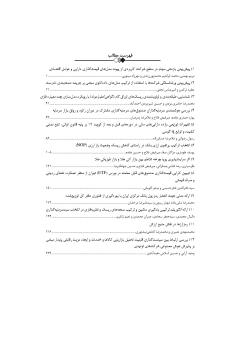انتخاب ترکیب پرتفوی ارزی بانک در راستای کاهش ریسک وضعیت باز ارزی (NOP)
محورهای موضوعی : مهندسی مالی
یوسف طوماری
1
,
مژگان صفا
2
*
![]() ,
میر فیض فلاح
3
,
میر فیض فلاح
3
![]() ,
حسین مقدم
4
,
حسین مقدم
4
1 - دانشجوی دکتری، گروه مدیریت مالی، واحد قم، دانشگاه آزاد اسلامی، قم، ایران
2 - استادیار،گروه حسابداری، واحد قم، دانشگاه آزاد اسلامی، قم، ایران
3 - دانشیار،گروه مدیریت مالی، واحد تهران مرکزی، دانشگاه آزاد اسلامی، تهران، ایران و عضو گروه پژوهشی مخاطرات مالی نوین، تهران، ایران
4 - استادیار،گروه حسابداری، واحد قم، دانشگاه آزاد اسلامی، قم، ایران
کلید واژه: ریسک, بانک سپه, پرتفوی ارزی, وضعیت باز ارزی,
چکیده مقاله :
هدف از پژوهش حاضر انتخاب ترکیب پرتفوی ارزی بانک در راستای کاهش ریسک وضعیت باز ارزی (NOP)است. این تحقق درصدد پاسخ به سؤال اینکه آیا امکان بهینهسازی پرتفوی ارزی بر اساس مدلهای مختلف ارزش در معرض خطر شامل Var، کاپیولا VaR و کاپیولا CVaR وجود دارد. این پژوهش در مقیاس کمی و مشاهدات بهصورت سری زمانی درصد بازدهی لگاریتمی روزانه دو ارز اصلی و متداول در تجارت کشور شامل دلار و یورو در بانک سپه از 17 فروردینماه 1392 الی پایان شهریور 1400 است . نتایج حاصل از سبد کارای انتخابی مبتنی بر این سه روش را نشان میدهد که با توجه به نتایج بهدستآمده مدل Copula GARCH VaR دارای مقدار شارپ بیشتری نسبت به دو روش دیگر است. از سوی دیگر نتایج میانگین شارپ بهدستآمده از پرتفوهای روی مرز کارا بین سه روش ارائهشده است که با توجه به مقادیر بهدستآمده درمییابیم اختلاف معنیداری در سطح اطمینان 95 درصد آماری بین میانگین سه روش ارائهشده وجود دارد که طی آن مدل Copula GARCH VaR رتبه بالاتری دارد.
The purpose of this research is to choose the composition of the bank's foreign exchange portfolio to reduce the risk of managing net open positions (NOP). This realization aims to answer the question of whether it is possible to optimize the currency portfolio based on different value-at-risk models, including Var, Copula VaR, and Copula CVaR. In this research, on a quantitative scale and observations in the form of time series, the daily logarithmic return percentage of the two main and common currencies in the country's business, including the US Dollar and the EURO, in Sepah Bank from 2013 April 6 to 2021 September 22.The results of the selected portfolio based on these three methods show that, according to the obtained results, the Copula GARCH VaR model has a higher Sharpe value than the other two methods. On the other hand, the results of the average Sharpe obtained from the portfolios on the efficient border between the three methods are presented, according to the obtained values, we find that there is a significant difference at the 95% statistical confidence level between the average of the three methods presented, during which the Copula model GARCH VaR is ranked higher.
_|Bayati, Gholamreza, Pour Zarandi, Mohammad Ibrahim. (2019). Designing a risk assessment model and determining the optimal currency portfolio of banks under the value-at-risk criterion and the exponential weighted moving average (EWMA) technique. Financial Engineering and Securities Management, 11(44), 44-73. (in persean).
Ahmed, L. (2015). The effect of foreign exchange exposure on the financial performance of commercial banks in Kenya. International journal of scientific and research publications, 5(11), 115-120.
Al Janabi, M. A. (2007). On the use of value at risk for managing foreign‐exchange exposure in large portfolios. The Journal of risk finance, 8(3), 260-287.
Anghelache, C., Anghel, M. G., & Grigorescu, D. L. (2019). Currency risk management model. Theoretical & Applied Economics, 26(3).
Barmuta, K. A., Ponkratov, V. V., Maramygin, M., Kuznetsov, N. V., Ivlev, V., & Ivleva, M. (2019). Mathematical model of optimizing the balance sheet structure of the Russian banking system with allowance for the foreign exchange risk levels. Entrepreneurship and Sustainability Issues, 7(1), 484.
Bitar, J. (2021). Foreign currency intermediation: Systemic risk and macroprudential regulation. Latin American. Journal of Central Banking, 2(2), 100028.
Eun, C. S., & Resnick, B. G. (1988). Exchange rate uncertainty, forward contracts, and international portfolio selection. The Journal of Finance, 43(1), 197-215.
European Central Bank (2014). Guide to the management of foreign currency and gold reserves of the European Central Bank Frankfurt: European Central Bank.
Inagaki, Y., & Ito, T. (2019). Portfolio optimization under NOP constraints: An empirical analysis of currency risk management in Japanese commercial banks. Journal of the Japanese and International Economies, 51, 1-11.
Johnson, G. (2020). Management of Canada’s Foreign Exchange Reserves. Asset Management at Central Banks and Monetary Authorities: New Practices in Managing International Foreign Exchange Reserves, 165-178.
Kisiala, J. (2015). Conditional value-at-risk: Theory and applications. arXiv preprint arXiv:1511.00140.
Kutan, A. M., & Atici, C. (2021). Managing foreign exchange risk with derivatives in Turkish banks. Emerging Markets Finance and Trade, 57(3), 725-742.
Markowitz, H. (1952). Portfolio selection. The Journal of Finance, 7(1), 77-91.
Mehdizadeh, M., & Mashayekhi, B. (2019). The effect of foreign exchange rate fluctuations on the performance of Iranian banks. Journal of Monetary and Banking Research, 12(43), 21-44.
Ranković, V., Drenovak, M., Urosevic, B., & Jelic, R. (2016). Mean-univariate GARCH VaR portfolio optimization: Actual portfolio approach. Computers & Operations Research, 72, 83-92.
Sharpe, W. F. (1966). Mutual fund performance. The Journal of Business, 39(S1), 119-138.
Skiadopoulos, G., & Louropoulos, D. (2021). Optimal currency portfolios in a globalized world: A conditional value-at-risk approach. Journal of International Money and Finance, 110, 102354.
Vial, J. (2019). Reserves management and FX intervention: Chile's experience. BIS Paper, (104f).
Yoon, S. M., & Shin, H. H. (2021). Optimizing currency portfolios to minimize net open positions: Evidence from the Korean commercial banking industry. International Journal of Finance & Economics, 26(1), 1166-1183.
|_

